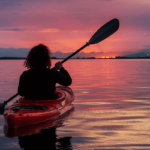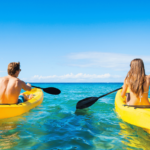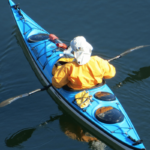Navigating the waters of distinction between a canoe and a kayak can be as challenging as paddling against a strong current. These two vessels, each with its own unique history and design, serve adventurers in different ways. If you’ve ever wondered why some paddlers sit on top while others are seemingly enclosed, or why the paddles look different, you’re in the right place. Dive into the nuances that set these watercraft apart and discover which one might suit your aquatic adventures best.
The Core Distinctions Between Canoes and Kayaks
The world of paddlesports often presents a fascinating dilemma: the choice between a canoe and a kayak. While at first glance, these vessels may appear remarkably similar, their differences are pronounced, shaping the very essence of the experiences they offer. One of the most notable distinctions lies in the design of the two. Canoes are generally open on top, offering a spacious interior that can accommodate multiple paddlers along with their gear. This characteristic makes canoes ideal for leisurely river trips or adventurous camping expeditions. Conversely, kayaks are designed with a closed deck, enveloping the paddler in a snug cockpit. This design enhances the kayak’s agility and performance in various water conditions, from calm lakes to tumultuous sea waves.
Another pivotal difference is the type of paddle used. Canoe paddles typically have a single blade attached to a long shaft, requiring a paddler to switch sides to maintain direction. Kayaks, on the other hand, utilize double-bladed paddles, allowing for a more rhythmic and efficient propulsion. This distinction not only affects the paddling technique but also influences the speed and maneuverability of the vessel on the water. Furthermore, the seating position in each vessel varies; canoeists sit on a bench or kneel, while kayakers sit with their legs extended forward, a posture that contributes to the kayak’s stability and control.
In conclusion, the choice between a canoe and a kayak hinges on the intended use, the paddler’s preference for comfort and control, and the type of water adventure sought. Whether embarking on a serene fishing trip in a canoe or navigating the dynamic rapids in a kayak, understanding these fundamental differences is essential for selecting the right vessel for your next waterborne journey.
Exploring Paddlesports: A Deeper Dive into Canoes and Kayaks
Delving deeper into the world of paddlesports reveals a rich tapestry of history, culture, and innovation that surrounds both canoes and kayaks. Each vessel carries with it a legacy of exploration, from the indigenous peoples utilizing canoes for transportation and trade to the Inuit and Aleut tribes developing kayaks for hunting in the Arctic waters. Today, this heritage is preserved and evolved through recreational activities, competitive sports, and a growing community of enthusiasts who cherish the connection to nature and the thrill of the paddle.
- Design and Functionality: Canoes offer an open design suitable for gear-heavy adventures.
- Paddling Techniques: The use of single versus double-bladed paddles affects maneuverability and speed.
- Seating Positions: Canoes allow for a more versatile seating arrangement, affecting comfort over long distances.
- Types of Activities: Choosing between a canoe and kayak depends on the nature of the water adventure.
- Cultural and Historical Significance: Both vessels have rich histories tied to indigenous practices and exploration.
The Fundamental Distinctions
At first glance, canoes and kayaks may appear similar, both offering serene ways to traverse water. However, substantial differences define their design, usage, and the experience they offer. A canoe is characterized by its open deck, which allows for a more spacious seating arrangement. Typically, canoeists navigate with a single-bladed paddle, employing a variety of strokes to control the boat’s direction and speed. This open design not only facilitates the carrying of additional gear but also makes entry and exit more straightforward, an advantageous feature during lengthy excursions or when portaging is necessary.
In contrast, kayaks are recognized by their closed decks, which envelop the paddler. This configuration significantly enhances the kayak’s stability and seaworthiness, particularly in choppy waters or during adverse weather conditions. Kayakers utilize a double-bladed paddle, allowing for efficient propulsion and maneuverability. The seated position in a kayak is lower in relation to the water, offering a heightened sense of connection with the aquatic environment and enabling a more powerful and direct paddling technique.
Furthermore, kayaks are often preferred for their agility and speed, making them the vessel of choice for whitewater adventures and long-distance touring. Canoes, with their ample storage and higher seating position, lend themselves well to recreational paddling, fishing, and family outings.
| Feature | Canoe | Kayak |
|---|---|---|
| Deck Type | Open | Closed |
| Paddle Type | Single-bladed | Double-bladed |
| Seating Position | Higher | Lower |
| Primary Use | Recreational, Fishing | Touring, Whitewater |
| Stability | Good | Excellent |
Understanding the fundamental differences between canoes and kayaks is crucial for selecting the most suitable vessel for your waterborne adventures. Whether you favor the open design and versatility of a canoe or the sleek efficiency and intimacy with the water provided by a kayak, both crafts offer unique ways to explore and enjoy the world’s waterways.
Design and Structure Differences
The distinction between canoes and kayaks lies deeply in their design and structure, aspects that influence their performance, handling, and usage. One of the primary differences is the vessel’s shape; canoes generally have an open deck, offering a spacious area that can accommodate multiple paddlers. This design is conducive for leisurely rides, fishing, and carrying substantial gear or supplies. In contrast, kayaks feature a closed deck, which envelops the paddler within a cockpit. This structure significantly enhances the kayak’s maneuverability and speed, making it a preferred choice for solo expeditions, whitewater adventures, and sea kayaking.
Another noteworthy difference is the type of paddle used for navigation. Canoe paddlers typically utilize a single-bladed paddle, requiring a technique that alternates strokes from one side of the boat to the other. This method demands a skillful balance and coordination, as the paddler must continuously switch sides to steer and propel the canoe forward. On the other hand, kayaks are equipped with double-bladed paddles, allowing paddlers to execute a more efficient and rhythmic stroke by alternating sides without the need to change the paddle’s orientation. This not only facilitates a quicker pace but also provides a more stable and straightforward means of control, especially in turbulent waters.
The seating position within these vessels also highlights their structural differences. In a canoe, paddlers either kneel or sit on an elevated bench, positioning them higher above the waterline. This posture provides a better vantage point for surveillance and interaction with the surrounding environment but can affect the boat’s center of gravity and stability. Conversely, kayak paddlers sit in a low-seat, with legs extended forward into the hull. This lower center of gravity offers enhanced stability and control, particularly in choppy conditions or when navigating tight turns.
| Feature | Canoe | Kayak |
|---|---|---|
| Deck Type | Open | Closed |
| Paddle Type | Single-bladed | Double-bladed |
| Seating Position | Elevated (sitting or kneeling) | Low (sitting with legs extended) |
| Maneuverability | Good (with skill) | Excellent |
| Preferred Use | Leisure, Fishing, Cargo | Solo expeditions, Whitewater, Sea kayaking |
Understanding the design and structure differences between canoes and kayaks not only enriches one’s knowledge but also aids in making an informed decision suited to one’s aquatic adventures. Whether embarking on a serene fishing trip in a spacious canoe or navigating the thrilling currents in a sleek kayak, recognizing these distinctions ensures a more enjoyable and efficient experience on the water. The choice between a canoe and a kayak ultimately depends on the individual’s preferred activities, paddling style, and comfort level, highlighting the importance of these fundamental aspects in the selection process.
Paddling Techniques and Positions
The distinction between canoeing and kayaking is not just limited to the structure of the vessels but extends significantly into the techniques and positions employed while navigating them. In canoeing, paddlers typically kneel on one or both knees or sit on a raised seat. This position offers a higher vantage point, enhancing visibility and leverage. The single-bladed paddle is wielded with a j-stroke to maintain direction and balance, a technique that requires skill and practice to master.
In contrast, kayaking involves sitting down with the legs stretched out in front. The lower position in a kayak can increase stability, especially in choppy waters. Paddlers use a double-bladed paddle, allowing for quicker and more efficient strokes. The alternating side-to-side paddling technique is fundamental in kayaking, enabling smooth and direct navigation. These differences in paddling techniques and positions underscore the unique experiences and challenges each vessel offers, making the choice between a canoe and a kayak dependent on the environment, purpose, and personal preference.
Additional Insights on Paddling Dynamics
The dynamics of paddling also vary significantly between a canoe and a kayak due to their design and the paddler’s interaction with the water. In a canoe, the higher center of gravity demands more balance and technique to prevent capsizing. This aspect makes canoeing both a challenging and rewarding experience, as paddlers refine their skills. On the other hand, kayaks, with their sleek design and lower center of gravity, offer greater speed and agility, appealing to those seeking a more intense connection with the water.
| Aspect | Canoe | Kayak |
|---|---|---|
| Position | Kneeling/Sitting | Sitting with legs extended |
| Paddle Type | Single-bladed | Double-bladed |
| Stability | Higher center of gravity, requires balance | Lower center of gravity, more stable |
| Visibility | Higher vantage point | Lower to the water |
| Speed and Agility | More effort for speed, good for leisure | Faster and more agile, suited for racing |
Intended Use and Versatility
The distinction between canoes and kayaks extends far beyond their physical structure, delving into their intended use and versatility. Canoes, with their open deck design, provide a spacious environment suitable for leisurely activities, fishing, and transporting goods or multiple passengers. Their stability and ease of entry and exit make them ideal for family outings and novice paddlers. In contrast, kayaks, recognized by their closed decks, cater to a different spectrum of activities. Designed for efficiency and speed, kayaks are the preferred choice for sea expeditions, whitewater adventures, and long-distance paddling. The snug fit of a kayak enhances the paddler’s control, making it suitable for tackling challenging conditions and for those seeking an intimate connection with the water.
Moreover, the versatility of these vessels is influenced by their design variations. Canoes come in shapes and sizes that accommodate a range of activities, from tranquil water explorations to competitive racing. The traditional single-bladed paddle allows for a relaxed, upright posture, which is comfortable over long distances but requires skill to master directional control. Kayaks, with their double-bladed paddles, offer more power and maneuverability, allowing paddlers to navigate through tight spaces and against strong currents with relative ease. This makes kayaks particularly versatile for exploring diverse environments, from calm lakes to the open sea and even narrow, twisting rivers.
It’s also worth noting that the evolution of materials and design technology has expanded the versatility of both canoes and kayaks. Modern advancements have led to the creation of inflatable models, which offer unparalleled convenience for transportation and storage. These innovations have made both canoes and kayaks more accessible to a wider audience, ensuring that regardless of one’s intended use, there is a suitable option available.
Further Insights into Canoe and Kayak Versatility
The conversation about the intended use and versatility of canoes and kayaks would be incomplete without mentioning the role of skill level and personal preference. For beginners, canoes often present a less intimidating entry point due to their open design and stability. However, as paddlers gain experience, they may gravitate towards kayaks for their agility and suitability for more adventurous activities. Ultimately, the choice between a canoe and a kayak often comes down to the individual’s lifestyle, the nature of the waterways they wish to explore, and their personal comfort level with each vessel’s handling characteristics.
Finally, the community and culture surrounding canoes and kayaks are as diverse as the vessels themselves. Enthusiasts often gather in clubs or online forums to share tips, organize outings, and discuss the latest gear. This sense of community plays a significant role in introducing newcomers to the sports and in the ongoing evolution of canoe and kayak design and use. Whether one prefers the serene joy of a solo canoe trip at dawn or the thrill of navigating rapids in a kayak, both offer a pathway to connecting with nature, fostering a sense of adventure, and promoting physical fitness.
- Leisurely activities and family outings are well-suited to canoes.
- Kayaks excel in sea expeditions and whitewater adventures.
- The design of canoes offers ease of entry, exit, and goods transport.
- Kayaks provide enhanced control and maneuverability for experienced paddlers.
- Modern materials have increased the accessibility and convenience of both vessels.
Historical Origins and Evolution
The historical roots of canoes and kayaks are rich and diverse, tracing back thousands of years to different parts of the world. Canoes were originally developed by the indigenous peoples of North America, primarily for transportation, fishing, and hunting. These boats were typically made from dugout trunks or constructed from birch bark, stretched over wooden frames. The word “canoe” itself stems from the Carib word “canoa,” indicating its deep-rooted cultural significance.
On the other hand, kayaks were ingeniously crafted by the Inuit, Yup’ik, and Aleut peoples of the Arctic regions. Designed primarily for the icy waters of the North, kayaks were built to be maneuverable and seaworthy, allowing hunters to stealthily approach marine animals. These were traditionally constructed using animal skins, such as seal stretched over a wooden or whalebone frame. The term “kayak” means “man’s boat” or “hunter’s boat,” underscoring its utilitarian purpose in these communities.
The evolution of both watercrafts has been significant over centuries. From their humble beginnings as essential tools for survival, canoes and kayaks have transformed into modern recreational and competitive vessels made from materials such as fiberglass, plastic, and Kevlar. This transition signifies not only technological advancement but also a shift in the cultural and practical applications of these boats. Today, they serve a wide array of purposes, from leisurely paddles on calm lakes to adrenaline-fueled white-water racing, reflecting both their heritage and versatility.
- Indigenous origins in different regions
- Construction materials: wood, birch bark, animal skins
- Canoes: developed for transportation and fishing
- Kayaks: designed for hunting in icy waters
- Modern advancements: fiberglass, plastic, Kevlar
Stability and Maneuverability
The concepts of stability and maneuverability are crucial when distinguishing between canoes and kayaks, each offering distinct advantages and challenges. Stability, in the context of watercraft, refers to the ability to remain upright and resist capsizing. Canoes, with their wider hulls, generally offer greater initial stability, making them feel more secure in calm waters. This stability is particularly beneficial for beginners or when the canoe is used for leisurely activities such as fishing.
Maneuverability, on the other hand, is how easily a vessel can be steered or turned. Kayaks excel in this area due to their sleek design and the double-bladed paddles used by the paddler. This design allows for swift and agile movements, making kayaks ideal for navigating through rough waters or tight spaces. The trade-off, however, is that kayaks might feel less stable to inexperienced users, especially in choppy conditions.
It’s also important to note that within each category, variations exist. For example, some kayaks are designed with wider hulls to increase stability for activities like fishing, at the cost of some maneuverability. Similarly, there are canoes that are built to be more agile, ideal for whitewater adventures, though they may require more skill to balance. Ultimately, the choice between a canoe and kayak will depend on the specific needs and preferences of the user, considering the balance between stability and maneuverability.
| Feature | Canoe | Kayak |
|---|---|---|
| Initial Stability | High | Varies |
| Maneuverability | Low to Moderate | High |
| Paddles | Single-bladed | Double-bladed |
| Typical Use | Leisure, Fishing | Racing, Touring |
| User Position | Sitting or Kneeling | Sitting |
In conclusion, the decision between choosing a canoe and a kayak hinges on understanding and weighing the aspects of stability and maneuverability. Each type of vessel has its unique set of characteristics tailored to different activities and skill levels. Whether you seek the serene stability of canoes for calm lake fishing or the swift maneuverability of kayaks for adventurous whitewater rafting, there is a perfect option out there for every enthusiast. By considering your personal needs, preferences, and the specific conditions in which you plan to paddle, you can select the ideal watercraft for your adventures on the water.
Understanding the nuances between these two popular types of watercraft will not only enhance your overall experience but also ensure that you are well-equipped for the adventures that lie ahead. Happy paddling!
I’m Adam Reynolds, a dedicated sports writer with a passion for both competitive gaming and betting. In my mid-thirties, I dive deep into the world of sports, providing insightful analyses and strategies to help readers make informed betting decisions. My experience spans various sporting events, where I blend my love for the game with a keen eye for betting trends. Whether I’m dissecting game tactics or offering betting tips, I aim to deliver content that is both engaging and practical. Join me as we explore the exciting intersection of sports and betting together.





